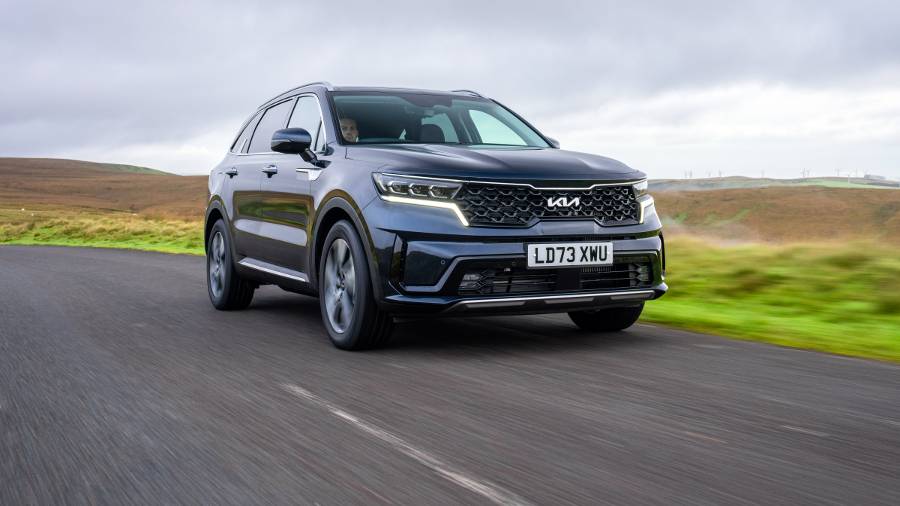
Kia Sorento PHEV Review

Introduction
The Sorento was always the poor (or tight) man’s Range Rover. But, in reality, being a seven-seater 4x4 was just about the only thing the two had in common.
The new Sorento isn’t likely to give the bosses at Jaguar Land Rover (JLR) sleepless nights, but make no mistake – it’s superb and closes the gap considerably.
Review Sections
Select's rating score* - 4.1 / 5
At a Glance
The front grille design has been refined and seems to take a bit of inspiration from JLR’s line-up. It looks less modest and far more imposing than the outgoing model, with a broader and less rounded appearance.
At the back, you can see the JLR influence, too – squint, and it reminds you of an old Range Rover Sport with some extra lines, although the taillights stand upright in rectangles, looking like they’ve been plucked from a Ford Mustang.
We got a fright at first, as when we stood next to the boot, it opened automatically so, if you’re carrying the shopping and can’t reach the keys in your pocket, this is an ingenious solution. You can then customise how quickly, and even how far, the boot opens via the car’s settings in the infotainment system.
Oh, and it looks enormous.
Key Features
For the trims, rather than fancy names (we quite liked ‘Grandiose Gangnam K-Pop Trim' in the office), they are simply numbered, and there's three to choose from.
They’re… um… 2, 3 and 4. No, we’re not sure what happened to 1 either.
Nevertheless, for the avoidance of doubt, trim 2 is the entry-level.
All grades come in a choice of six body colours – Brown, Black, Red, Graphite (Grey), White and Blue and include dual-zone climate control. They are all four-wheel drive automatics, and all the petrol versions are 1.6-litre hybrids, but you can choose between the plug-in (PHEV), as tested here, or a self-charging (HEV), while the diesel is a 2.2-litre engine with no hybrid technology.
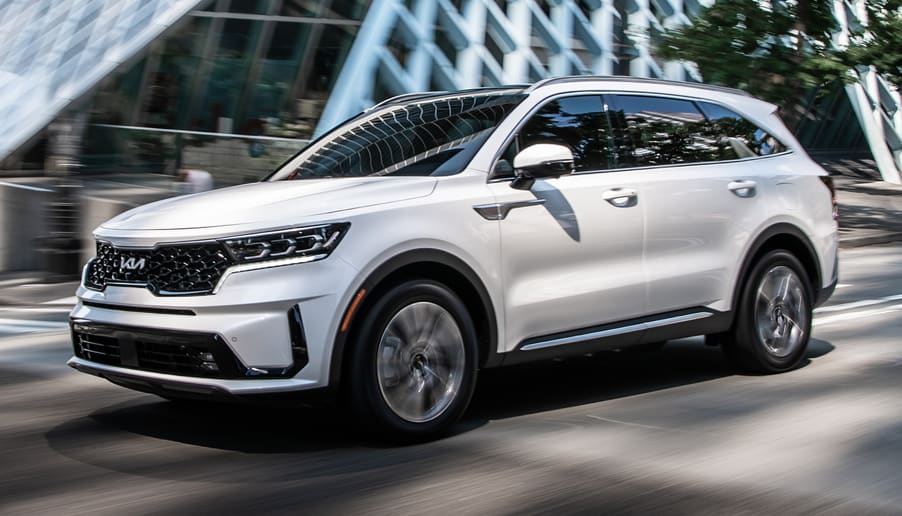
Trim 2 gets LED headlights, 17-inch alloys if you choose the HEV, and 19-inch alloys on the PHEV, an 8-inch touchscreen incorporating Apple CarPlay and Android Auto, plus you get a heated steering wheel and heated seats. A reversing camera is included, too, along with smart cruise control.
Trim 3 is the grade you’ll have to go for if you want the diesel engine – but the alloys on all models are 19-inches, and the touchscreen is bigger at 10.25-inches. You get the nice automatic boot lid, too, along with a wireless phone charger, as well as lumbar support on the front seats. In addition to the heating on Trim 2, the two outer seats in the middle row are also heated.
Trim 4 adds a panoramic sunroof, leather seats, heated rear seats, a head-up display and a Bose sound system. At the same time, a blind-spot camera is added, displaying the image on the digital instrument display. The icing on the cake is provided with electric blinds.
Overall, when you look at what you get, the Sorento is already massively improved.
Even so, we're not sure whether people in Chelsea would buy a Kia, but this would undoubtedly be considered a Chelsea Tractor given its size. However, you can do your best to shake off the tag as there are three modes for off-roading – Snow, Mud and Sand.
We haven't tested it off-road, but Kia is serious that this car can perform well on the rough stuff, rather than just looking the part while taking up room on the King’s Road.
There’s also another three driving modes depending on how economical you want to be – Eco (which relies mainly on the electric motor), Sport (which doesn’t) and Smart (which lets the car do its best to manage all the "hybriddy" stuff for you).
In addition, you can run the plug-in hybrid versions in electric-only mode.
Range & Batteries
The 2.2-litre diesel produces 261PS and is the most powerful, which is a shame seeing as it’s all engine with no hybrid variant on offer.
But the good news for dual-fuel fans is that the top-of-the-range plug-in hybrid matches it.
The self-charging version (HEV) has two variants, producing 119 and 226PS. The plug-in version (PHEV) also has two variants, but these are 226 and 261PS.
In the model we tested – the 261PS plug-in variant – a 13.8kWh battery is provided, which Kia says can do 35 miles in electric-only mode.
It's also worth remembering that, even if you have the PHEV, you can still get the engine to charge up the batteries, so it’s worth considering whether the HEV or the PHEV better suits your needs.
Performance & Drive
The Sorento is very nice to drive. Considering the car’s vast size, the lack of body roll is impressive, as is the acceleration – the top-of-the-range PHEV delivers power well off the line, dealing with 0-62mph in just 8.4 seconds. However, the HEV version does seem to have a quicker burst of energy.
Although the steering is on the dull side, the SUV handles well, and don't expect sporty drivability – this is a big lug after all. That said, Kia has done a fair job to maximise the car's handling performance, despite the weight and a higher centre of gravity compared with a small hatchback.

Overall, the Sorento is refined, and the transition between electric and hybrid modes is perfectly acceptable. It can be a bit laggy, though, if you floor it and demand all the power in one go, as you have to wait for the engine to switch itself on, change down a gear and come to life.
The automatic gearbox is smooth and keeps the ride relaxed at low speeds, despite the many gear changes that naturally come with around-town driving.
Charging
Both the HEV and the PHEV models will charge themselves. Although with the plug-in version, you have the option to … well … plug it in.
Keeping the PHEV charged is critical for good fuel consumption, though, as you’ll be able to reap the full benefits of all the battery power.
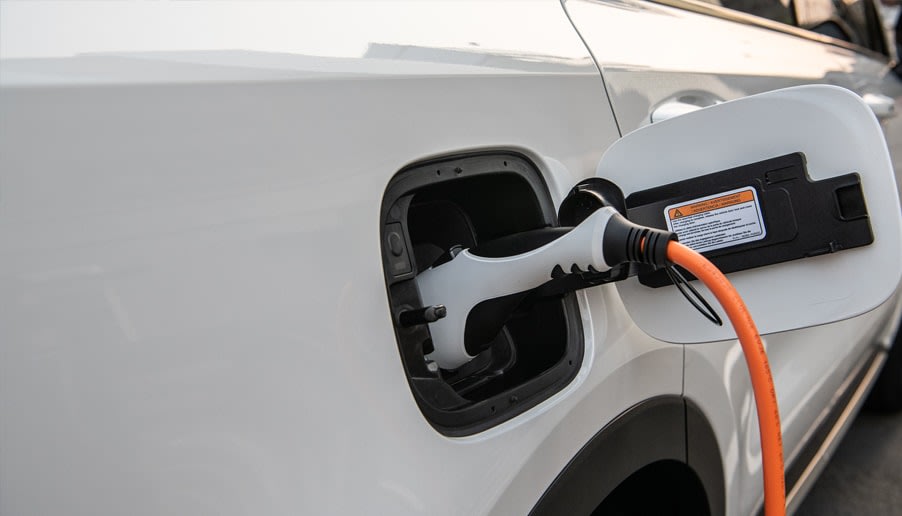
Charging the Kia takes around five hours using a standard home wall plug, but a wall box will reduce this.
If you opt for the PHEV version, the charging cables are included with the vehicle. This might sound obvious, but it’s worth noting that a surprisingly large number of hybrid manufacturers sell the charging cables as optional extras.
Running Costs & Emissions
The most potent PHEV, the 261PS variant, claims it'll do up to 176.6mpg, producing 38g/km of CO2 in the process.
Of course, this stonkingly good miles-per-gallon figure is heavily geared around the battery, and that’s based on the assumption that it’s fully charged. If you empty it, you’ll only be getting around 35mpg in practice.
Fuel economy is claimed to be around 40.9mpg in the HEV variants, producing 158g/km of CO2, while the diesel will manage a claimed 42.2mpg, making 176g/km of CO2.
All Sorento models come with Kia's standard seven-year, 100,000-mile warranty, so that should cut down a lot on maintenance costs in the event of any issues. However, Kia has a superb reputation for reliability.
Interior & Technology
Cars from South Korea and Japan have long been derided for their lack of style, but, boy, has Kia worked hard on its products.
The interior is vastly improved on the predecessor. It looks much more attractive, with the layout – a mixture of patterns, soft surfaces and silver – adding to a far less cluttered dashboard.
Everything you need is there, although much of it is now housed away in the touchscreen, apart from the air conditioning controls, which are operated by physical buttons and switches.

Though we recommend upgrading to the larger screen if you can, the infotainment system is sound, as it's sharper and has a nicer graphics package. But even if you’re stuck with the smaller one, many systems are a lot worse. It includes Android Auto/Apple CarPlay, and the screen – even the smaller one – is responsive and lag-free.
Housed within the touchscreen, you’ll find information and readouts from the hybrid system, vehicle settings and customisation options, plus everything else you'd expect to see, such as the radio and Bluetooth connectivity.
Behind the steering wheel, there’s another digital display giving you various readouts, which is very clear and well presented.
The silver centre console includes the gear and driving mode selectors. It looks nice, although the plastics here do seem a little on the cheaper side than elsewhere in the interior.
If there’s one thing we don’t like about the interior, it’s that the silver surrounds on the dashboard make the air vents stand out a bit too much, which might not suit all tastes. But we're splitting hairs – and at least Kia has gone for a mix here rather than the bland boringness of a monotonal colour scheme.
Make no mistake – this is a much-improved effort, and we reckon you’ll need to be thinking about the premium brands if you want to do better than this.
The SatNav system even tells you where the nearest charging stations are – and you'll find USB slots on all three rows of seats.
Practicality & Boot Space
The rear is impressive, with bucket loads of space. The middle row seats, which can recline, move forward automatically at the push of a button so you can get to the back.
This means they are straightforward to move, which should help accommodate unusually shaped objects in the boot, whilst still fitting passengers in, or a mixture of adults and kids on the middle and back rows if you need to.
It also means there’s plenty of legroom, and the only place taller people will struggle is if they're in the third row sitting back as far as possible. This is where headroom might be in short supply, as the roofline slopes down slightly towards the rear.
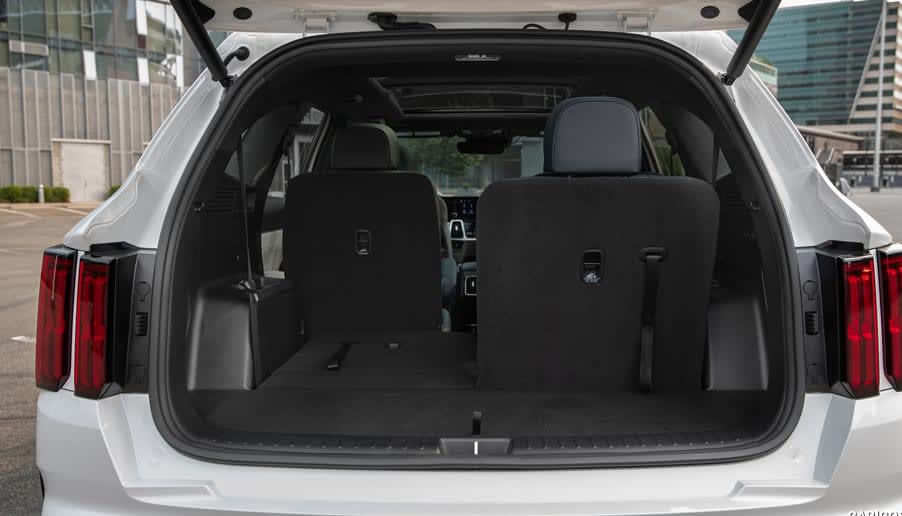
Storage is plentiful and convenient – and there are two cup holders in the centre console, as well as a wireless charging surface in the front.
The panoramic sunroof brightens up the massive interior at the cost of a bit of headroom, but the loss is not noticeable.
Even with all three tiers of seating in place, there's a sufficient amount of boot space. With the rear seats folded, 608-litres of space is available, but this increases to a whopping 1996-litres with the middle seats folded away (you will get very slightly more boot space with the diesel version, due to its lack of batteries under the floor).
Amazingly, the boot space is smaller than its rivals – the Skoda Kodiaq has 720-litres (expanding to 2065), and the Peugeot 5008 has 780 (albeit it only increases to 1940).
This is unlikely to be a dealbreaker, though, as unless you’re planning on moving a grand piano, there are very few transportable items that won't be swallowed whole by the cavernous boot of the Sorento.
Safety
Kia provides loads of safety equipment to keep you in one piece on the road.
The adaptive cruise control maintains the gap between you and the vehicle in front, while lane keep assist will ensure you don’t drift into oncoming traffic on the motorway.
The top-of-the-range trim 4 will also give you blind-spot monitoring and automatic emergency braking, which should ensure you don’t run into objects when parking or driving at a low speed.
The Sorento has been tested by Euro NCAP, earning a full-fat five-star rating, scoring 82% for adult occupants, 85% for child occupants and 87% for safety assists.
Options
It's pretty common for certain paints (especially if they're labelled metallic or pearlescent) to cost a bit more, but Kia is taking the biscuit a bit here.
Even if you have the top-of-the-range trim, unless you want ‘Essence Brown’ as the body colour, you might find you’re paying extra for any of the other five colours.
There’s a choice of several designs for your alloys wheels, a tailgate strip, a side step and various other bits of trim to add that extra bit of personalisation on the Sorento’s exterior, along with a roof rack and roof box.

On the inside, you can purchase a cradle to attach tablets to the back of the seat in front, a dashcam, floor mats, a choice of colours for LED lights that illuminate the footwell and even a special coat-hanger for your business suit.
If you like the Kia logo so much that you want it projected onto your driveway at night, there’s an option for that too.
Rival Cars
Other cars you might like to consider are the Peugeot 5008 and the Skoda Kodiaq, although we're confident the Kia is the better of the three.
The entry-level Kodiaq and 5008 are both cheaper, though. And if you start with those entry-level models and work your way up, you’ll find that you’ll be around two-thirds of the way towards their top-of-the-range models before you find one that matches the asking price for an entry-level Sorento.
Kia has done such a good job that it deserves to be ahead of both rivals – but it could be risking pricing itself out of the market by aiming so far above them.
Besides this, if a seven-seater is what you’re after, it’s also worth bearing in mind that, for about the same money as the Sorento, you could be driving away in a Mercedes GLB. At the same time, a Land Rover Discovery Sport will save you several thousand off the Kia’s list price – and, sadly for Kia, the attractiveness of both badges will undoubtedly turn heads.
Verdict & Next Steps
Overall, the Sorento is very impressive. You could even say it’s shocking, just in exactly the opposite way that you’d expect.
It is amazingly better than its predecessor, and you will struggle to find a better seven-seater 4x4 without including the premium brands.
Kia still has some way to go, but it's closed the gap to the big Bavarians.
Other than the incredibly bizarre “anything but brown is an optional extra” for the exterior colour, we love it. Mind you; our test car was blue.
The amount of equipment provided as standard is generous, but you pay significantly more than its rivals. Kia appears to be trying to distance itself from them deliberately, but it's justified.
It is worth considering whether you need the plug-in or self-charging version based on how far you drive and how often you’re likely to be able to charge it up should you opt for the PHEV.
But the miles-per-gallon figure in the PHEV is not to be taken lightly. Very few people want big 4x4s for the fuel economy, and even fewer will expect such an offering to come without a catch.
But now, thanks to Kia’s ingenuity, you can finally have a quality car with a quality interior and lots of tech that’ll manage over 175mpg – as long as you don’t mind plugging it in each night.
Where to next?
View latest Kia Sorento PHEV leasing deals - guide price from £445.89 per month inc VAT**
Looking for a great leasing deal? Check out our incredible range of car lease deals
Read our latest Reviews and find the right model for you
Want to know more about leasing? Take a look at our comprehensive Leasing Guides
Interested in everything motoring? Why not catch up on all the latest Car Leasing News.
*Score based on Select’s unique meta score analysis, taking into account the UK’s top five leading independent car website reviews of the Kia Sorento PHEV
**Correct as of 25/08/2021. Based on 9 months initial payment, 5,000 miles over a 48 month lease. Initial payment equivalent to 9 monthly payments or £4,013.00 Ts and Cs apply. Credit is subject to status.
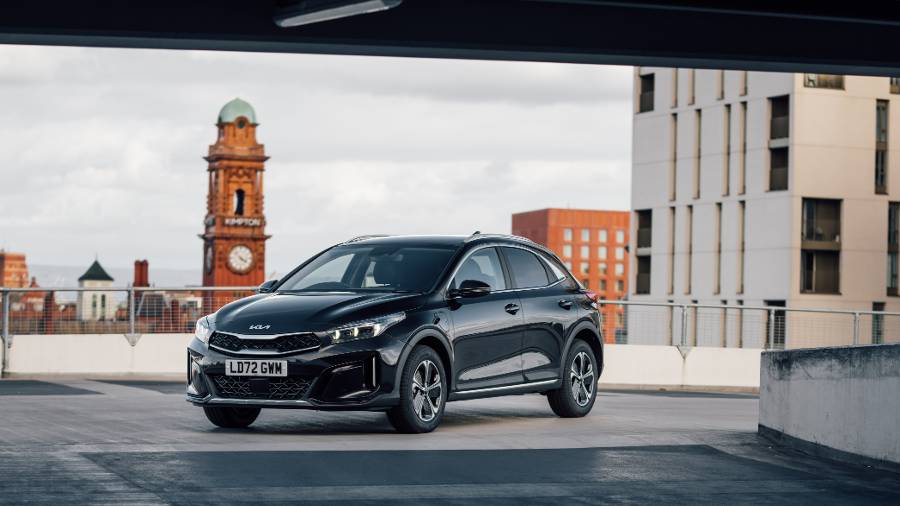
.jpg)
